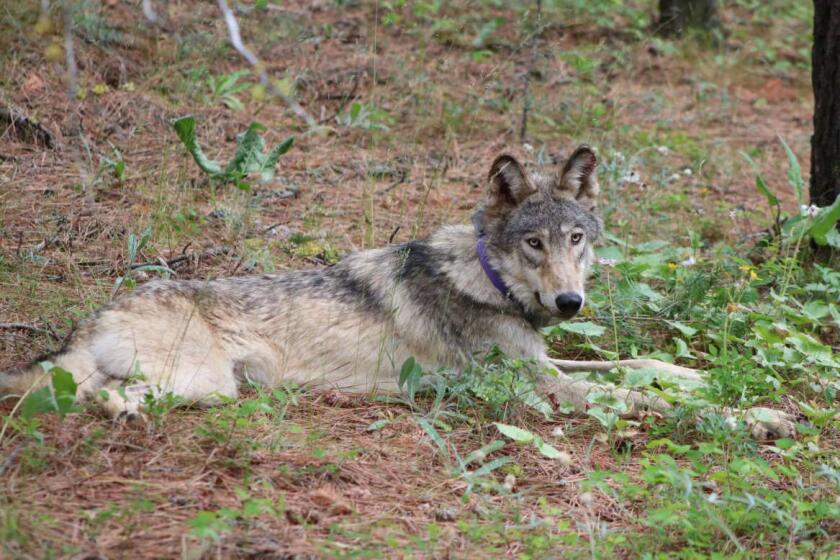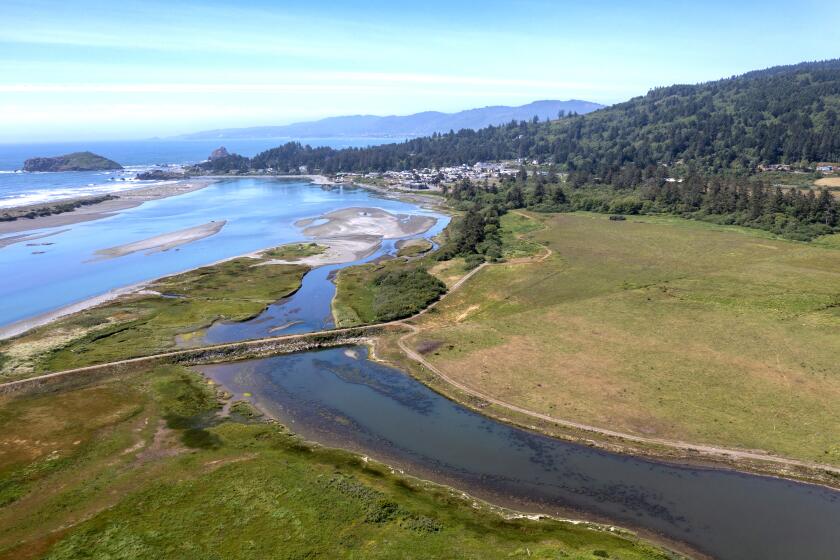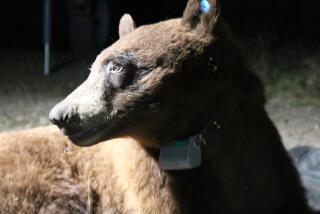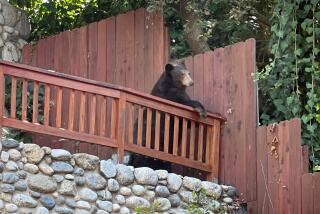Mother bears and cubs battle for survival as wildfire, drought and traffic take heavy toll
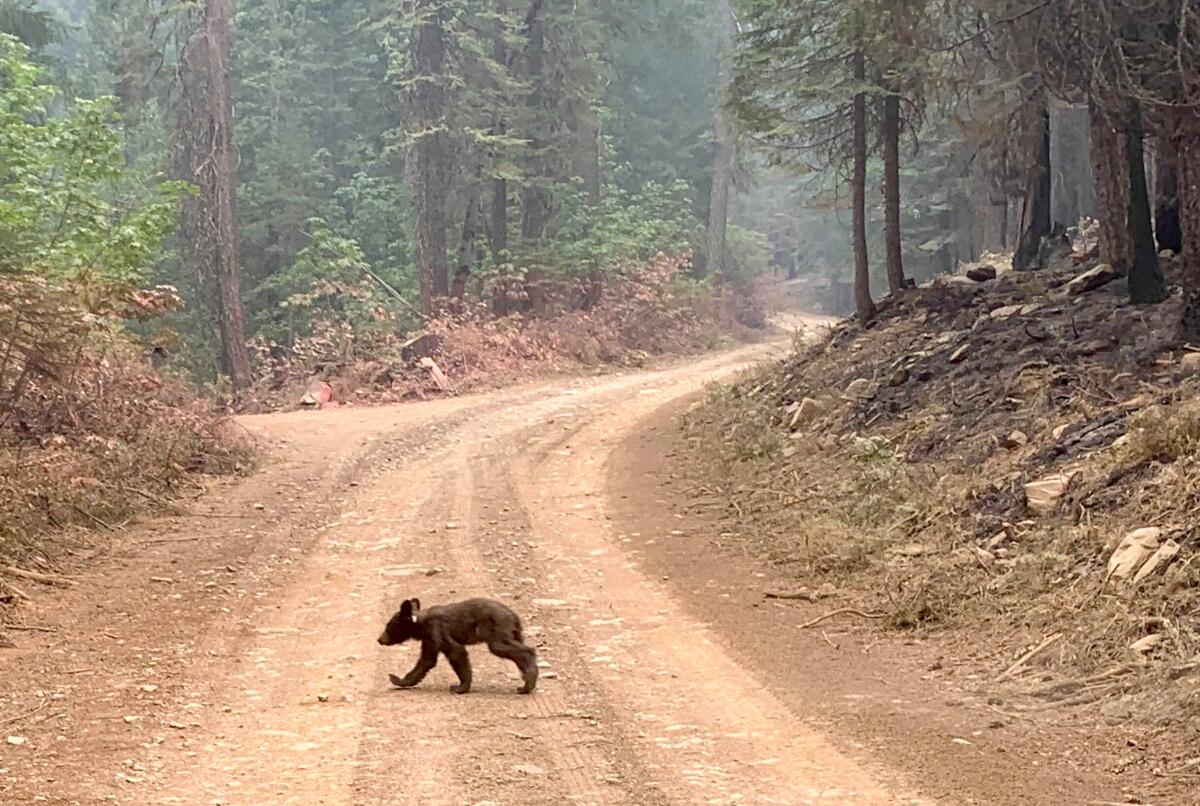
- Share via
Whether emblazoned on California’s flag or described in myth, the bear stands as a potent symbol of courage and strength — a ferocious embodiment of the North American wilderness.
In reality, however, the bear is vulnerable.
Nearly a century after the California grizzly was hunted to extinction, its less aggressive cousin, the black bear, is being killed in record numbers on California highways, experts say.
The unprecedented surge in deadly vehicle strikes is likely the result of bears fleeing massive wildfires in the Sierra Nevada, as well as the effects of drought, according to biologists. With traditional foraging grounds either desiccated or charred by flames, bears are moving to lower elevations in search of food and coming into dangerous contact with humanity.
“I can’t think of a worse situation for wildlife — bears running for their lives from fire and then getting whacked by cars,” said Fraser Shilling, director of the Road Ecology Center at UC Davis. “It’s a biological tragedy compounded by the fact that humans are responsible for the climate changes that set the stage for these increasingly immense and deadly wildfires.”
In an epic search for territory and mates, the gray wolf from Oregon had ventured hundreds of miles to the very edge of Southern California’s crowded suburbs.
Because of a lack of coordinated reporting, the number of bears struck and killed statewide is unknown. But researchers at Caltrans and the Road Ecology Center monitor a 108-mile stretch of U.S. 395 in the Eastern Sierra and say it suggests that pregnant females and cubs are facing extreme hardship.
“Since record-keeping of bear collisions began in 2002, we have not had a significant peak of collisions as we did in 2021,” said Katie Rodriguez, a Caltrans senior biologist based in Bishop in Inyo County.
In 2019, four bears were reported killed along the highway, and in 2020, no dead bears were reported. But last year, 13 bears were struck and killed by vehicles — 10 in September and October, when the animals search relentlessly for food, desperate to fatten up before hibernation.
Prior to 2021, the highest number of bears struck and killed by traffic along Highway 395 was nine; that occurred in 2007 and 2018. However, biologists caution that bear body counts then were much less accurate than they are now.
State biologists said six of the 10 bears struck in September and October were female, two were male and two were of unknown gender. Two of the females, both of which had cubs, were killed on consecutive days in Walker River Canyon, north of the town of Bridgeport.
Unable to fend for themselves, orphaned cubs stay close to their dead mother, making sounds that eerily resemble those of human babies crying, biologists say. Such was the case for two cubs found Sept. 6. They were captured and transported to a state wildlife care facility in Sacramento and are expected to be released into the wild in the spring, officials said.
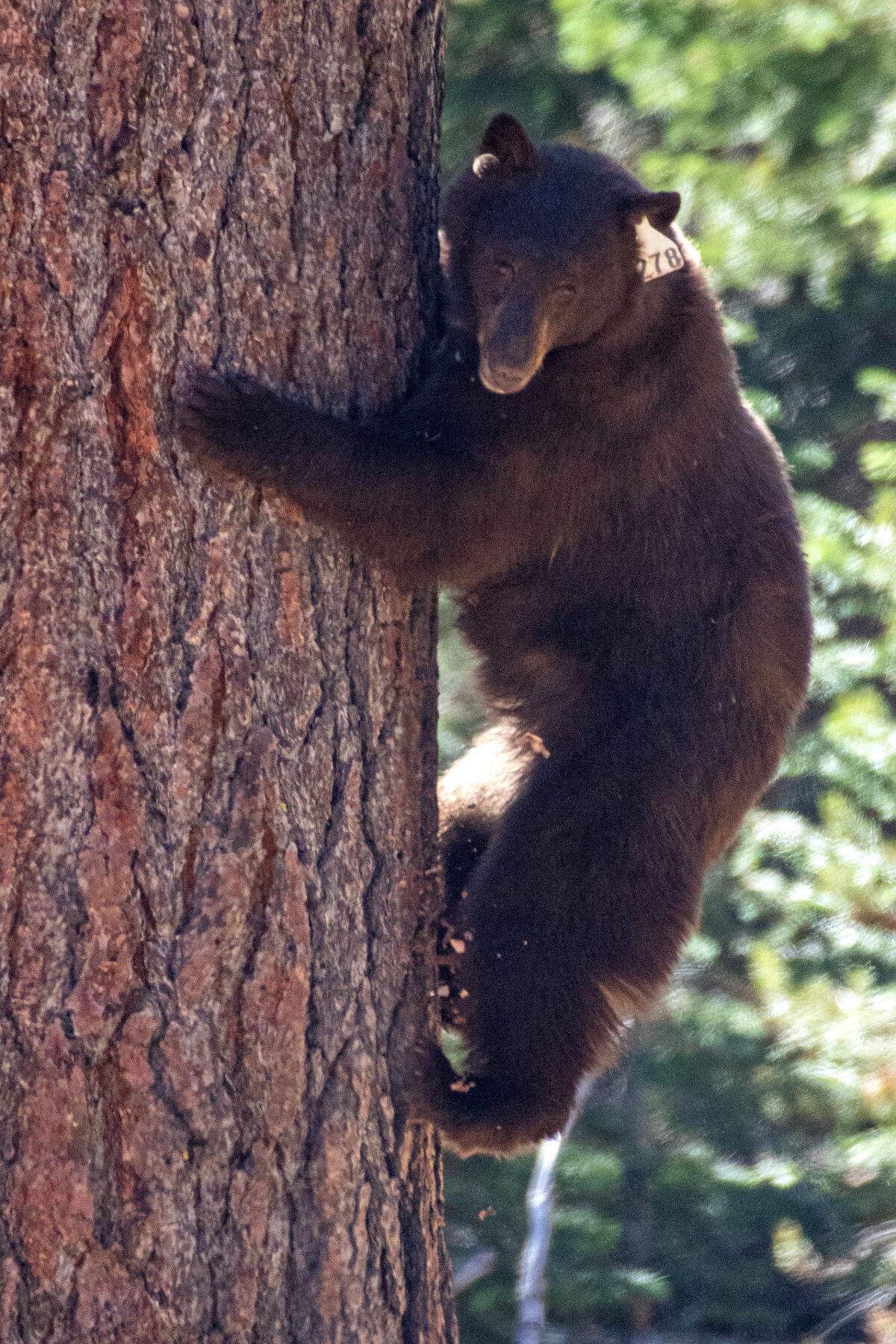
However, a cub found close to its dead mother the next day, just a few miles down the road, “dispersed and was never seen again,” said Michael Brown, an environmental scientist for the California Department of Fish and Wildlife.
None of the bears that were killed were collared, and biologists theorize they were among an untold number trying to escape walls of flame and suffocating smoke from last summer’s catastrophic Tamarack, Caldor and Dixie fires.
Together, the wildfires obliterated nearly 2 million acres of premier habitat from July to Oct. 26, leaving bears to search for new sources of food and water.
Subscribers get early access to this story
We’re offering L.A. Times subscribers first access to our best journalism. Thank you for your support.
It was toward the end of the summer of 2021 that “droves” of displaced bears began lumbering into Mammoth Lakes, according to Steve Searles, a local resident who has carved out a career as a “bear whisperer” — someone assigned to protect the ski village from the animals.
“I knew those bears were from someplace else,” Searles said, “because I had made it my business to know every bear in Mammoth Lakes from the day it was born to the day it died.”
Led by a sense of smell 100 times keener than that of humans, the newcomers were lured by the odor of dog food, koi ponds, restaurant dumpsters brimming with scraps, and manicured lawns and gardens. Searles called them the “lucky survivors” of fire-stripped forests to the north.
“But we’ll never know the number of bears that were hit by cars, trucks and tour buses,” he said, “and then dragged themselves off the road and died in places not easily seen through the rearview mirror.”
When a coveted ranch on the most pristine river in California was suddenly up for sale, a shocking history — and a massacre — bubbled to the surface.
Caltrans biologist Rodriguez wouldn’t argue with that.
“Several factors may lead to an increase in bear-vehicle collisions in the eastern Sierras, particularly in September and October,” Rodriguez said, “including their need to consume more than 20,000 calories per day prior to hibernation, continued drought in typically wet habitat and wildfires that remove seasonal food sources.”
But last year, she added, “black bears likely traveled further distances than normal to find resources, thus encountering roads and highways more often.”
Many bears on the move are pregnant females desperately searching for food and water in unfamiliar terrain; in late December, the area was suddenly buried in a record-breaking 17-plus feet of snow.
Wildlife activists face a heavy emotional toll.
“To understand this situation, you’ve got to put yourself in the mind of a mother bear in total emergency survival mode,” said Ann Bryant, executive director of the nonprofit Bear Education Aversion Response League and a resident of the Lake Tahoe Basin for 35 years.
“Normally, black bears breed in summer,” she said. “After that, a female’s fertilized eggs suspend development until implantation occurs in the uterine wall in November and December, during hibernation. This cycle, which is called delayed implantation, ensures that cubs will emerge from their den in the spring, when food is abundant.
“But if a pregnant female hasn’t gained enough weight, the eggs won’t implant, and she won’t give birth to cubs,” Bryant added. “That worries me, because what we saw last breeding season were a lot of female bears far from home and desperately searching for food and a cave in which to give birth to a new generation of cubs.”
In the prewinter season, bears typically eat for 22 hours a day. Although they are born blind, nearly hairless and no more than 9 inches long, females will reach an adult weight of about 200 pounds, and males are larger, with some topping 600 pounds.
Now, scientists and wildlife advocates are waiting to see if a significant number of the hibernating bears in Mono County will be welcoming new arrivals in the spring.
“A lot of female bears in the Sierra Nevada range were taken out of commission by all the forces working against them last year,” Shilling said. “It’s not unreasonable to wonder if those losses could impact the Sierra Nevada’s black bear population for several years to come.”
Until now, California’s black bear population has been robust and healthy, nearly tripling over the last 25 years. The California Department of Fish and Wildlife estimates that 30,000 to 40,000 black bears roam statewide, the most in the nation and twice as many as in Montana.
To reduce the carnage of bears and other wildlife important to the ecology, culture and economy of the region, a consortium of agencies led by Caltrans plans to construct a $17-million network of safe passages spanning a “vehicle-wildlife collision hot spot” near the intersection of 395 and State Route 203, between the communities of Crowley Lake and Mammoth Lakes. That is where Caltrans road crews clear the carcasses of a few black bears and 140 mule deer each year, on average.
In the meantime, state crews will continue to use earthmovers to scoop up the remains of bears, deer and other species killed by cars and trucks, drop them into off-highway depressions and cover them with dirt.
